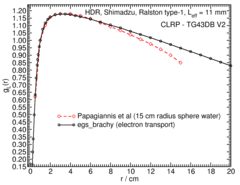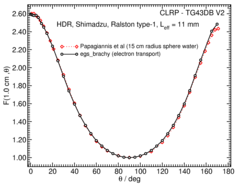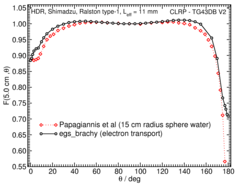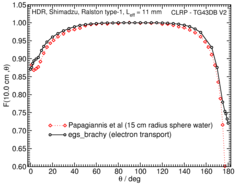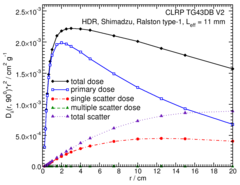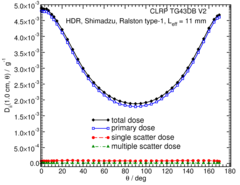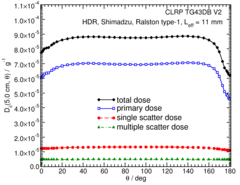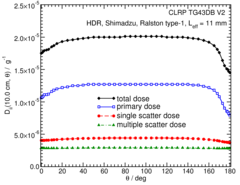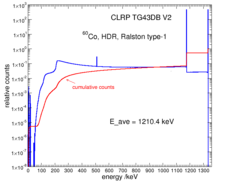
Source Description:
Dimensions for the Shimadzu Co-60 HDR Ralston type 1 source are taken from the study by Papagiannis et al.1 The source consists of two Co-60 symmetric cylindrical active pellets (density 8.9 g/cm3), 1.0 mm long and 1.0 mm in diameter, spaced by an AISI 316L stainless steel rod (density 8.02 g/cm3), elemental composition: 68.92% Fe, 16% Cr, 10% Ni, 2% Mo, 2% Mn, 1% Si, 0.08% C), 9.0 mm long and 1.0 mm diameter. The pellets centre is offset by ± 5.0 mm from the source centre. The source is enclosed in a 3.0 mm diameter AISI 316L stainless steel capsule. The encapsulation consists of an end weld composed of a 1.50 mm radius of a hemisphere offset from the source center by 7.0 mm. The hemisphere end cap is attached to a 1.5 mm long and 1.5 mm radius solid cylindrical section followed by a 14.0 mm long hollow section with an inner and outer diameter of 1.5 mm and 3.0 mm, respectively. This section is followed by an 8.0 mm long and 3.00 mm diameter solid cylindrical AISI 316L stainless steel. Air fills the unoccupied volume in the source. The overall source length is 25.0 mm and the active length is 1.10 mm. The mean photon energy calculated on the surface of the source is 1210.40 keV with statistical uncertainties < 0.001% .
Note: All the results presented in the Table, Figures, xlsx, and zip files are with electron transport in phantom except where noted.
Dose Rate Constant - Λ :
Dose-rate constants, Λ , are calculated by dividing the dose to water per history in a (0.1 mm)3 voxel centred on the reference position, (1 cm, Π/2), in the 80x80x80 cm3 water phantom, by the air-kerma strength per history factor (scored in vacuo). Air kerma per history is always calculated using a tracklength estimator in a 10x10x0.05 cm3 air voxel located in vacuo on the transverse axis 100 cm away from the source and then corrected (kr2 = 1.00217) for the lateral and thickness dimensions of the scoring voxel to give the air kerma per history on the central axis at a point 100 cm from the source’s mid-point as described in our previous study2, 3. Low-energy photons emitted from the source encapsulation are suppressed in the air-kerma calculations by discarding all photons with energy less than 10 keV (i.e., PCUT set to 10 keV in EGSnrc). MC uncertainties are only statistical uncertainties (k=1).
| Author | Method | Λ (cGy h-1 U-1) | Abs. Uncertainty |
| Safigholi et al (with e- transport) 4 | 10x10x0.5 cm3 voxel at 100 cm | 0.8822 | 0.0010 |
| Safigholi et al (no e- transport) 4 | 10x10x0.5 cm3 voxel at 100 cm | 0.8742 | 0.0002 |
| Papagiannies et al (no e- transport)1 | Monte Carlo (extrap) | 0.878 | 0.004 |
Radial dose function - g(r):
The radial dose function, g(r), is calculated using both line and point source geometry functions and tabulated at 36 different radial distances ranging from 0.2 cm to 20 cm.
Anisotropy function - F(r,θ):
Anisotropy functions are calculated using the line source approximation and tabulated at 12 radii from 0.25 cm to 20 cm and 47 unique polar angles with a resolution of 5° or better. The anisotropy factor, φan (r), was calculated by integrating the solid angle weighted dose rate over 0° ≤ ϑ ≤ 180°.
Click images for higher res versionsAlong-Away Dose Data:
Along-away dose data are tabulated at 16 away distances from 0 cm to 20 cm and 31 along points from -20 cm to 20 cm. Doses are normalized to SK , the air-kerma strength.
Primary and Scatter Separated (PSS) Dose Data: Dii (r,θ):
Primary and Scatter Separated (PSS) dose data are tabulated at 12 radii from 0.25 cm to 20 cm and 47 unique polar angles with a resolution of 5° or better. High resolution (Δr = 1 mm, ΔΘ = 1°) primary scatter dose data are also available in .csv files. For the purposes of these calculations, any photon escaping the source encapsulation is considered a primary. Only photons which scatter within the phantom are counted in the scatter tallies. Doses are normalized to the total photon energy escaping the encapsulation.
High resolution (1mm/1°) Tabulated D ii (r,θ) data in .csv format: Zipped archive
Photon Energy Spectra
Photon energy spectra generated by the source model are calculated using the egs_brachy surface count scoring option to get the spectrum on the surface of the source. The plotted values are the counts per MeV in 1 keV bins, normalized to 1 count total in the spectrum. The MC calculations have a statistical uncertainty less than 0.001% on the mean energy. The spectrum data are available in xmgrace format below.
Photon energy spectra on source surface: xmgrace
References:
1. P. Papagiannis, et al, Monte Carlo dosimetry of 60Co HDR brachytherapy sources, Med. Phys., 30 , 712–721, 2003
2. R. E. P. Taylor et al , Benchmarking BrachyDose: voxel-based EGSnrc Monte Carlo calculations of TG--43 dosimetry parameters, Med. Phys., 34 , 445 - 457, 2007
3. D. W. O. Rogers, Inverse square corrections for FACs and WAFACs, Appl. Radiat. Isot.,153 ,108638, 2019
4. H. Safigholi, M. J. P. Chamberland, R. E. P. Taylor, C. H. Allen, M. P. Martinov, D. W. O. Rogers, and R. M. Thomson, Update of the CLRP TG-43 parameter database for high-energy brachytherapy sources, to be published (Current calculation)
Carleton Laboratory for Radiotherapy Physics
